William Gibson’s Alien III: Space Commies in Mallworld
Following news that it's being adapted for a comic series, Padraig looks back at William Gibson's unused script draft for Alien III...
Long before Prometheus or Alien: Covenant proved divisive among fans of the Alien franchise, David Fincher’s Alien 3 made a good stab at sending devotees into a frothing rage. It robbed Aliens of its happy ending by killing Newt and Hicks in the opening scene, the tone was consistently downbeat and Ripley herself perished in the climax. Of course, Alien 3 has since been reappraised and found its own devoted following, but it’s fair to say it was neither what fans wanted nor expected back in 1992.
Alien 3 came six years after James Cameron’s second movie proved a resounding success, taking the haunted house in space formula of the original film and turbocharging it into an action spectacle. It had a great cast, memorable dialogue, intense action and fascinating additions to the mythology – in short, a sequel was inevitable. But there-in lay a major issue: should the next movie give audiences more of the same visceral thrills or morph into a new genre like the leap from Alien to Aliens?
This question clearly gave returning producers Walter Hill and David Giler a headache, since no less than ten writers spent years developing wildly differing concepts for Alien III. The most famous would be Vincent Ward’s ambitious – and downright odd – script involving Ripley crash-landing on a wooden planet populated by technology rejecting monks – needless to say, a xenomorph hitched a ride with her. There was also Eric Red’s much derided script, featuring xenomorph cows, chickens and dogs, a giant, Akira-esque Alien monster, a downright pornographic zero gravity sex scene and a setpiece where a housewife battles a xeno with a chainsaw; Weaver herself later dubbed this draft “a real disaster.”
Before any of these subsequent screenplays William Gibson was the very first writer on Alien III, and with the recent announcement his unused draft is being turned into a comic series, now’s the perfect time to look back at the author’s very different take on the third movie.
Big problem in Mallworld
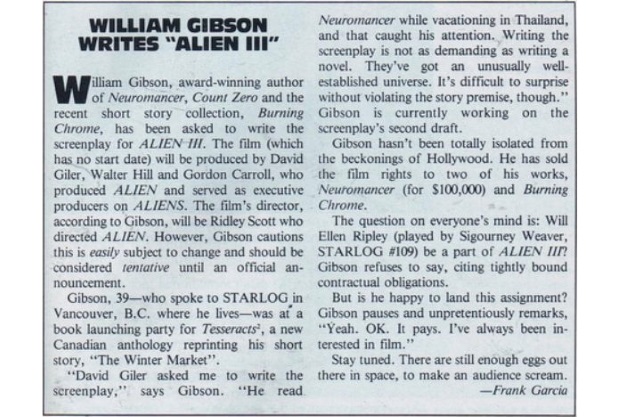
James Cameron made it clear he had no intention of coming back for Alien III, so once 20th Century Fox greenlit another movie, Giler and Hill had to start from scratch. Early concepts included an Alien being hunted down in a Blade Runner-style metropolis, but once Giler read William Gibson’s ground-breaking cyberpunk novel Neuromaucer he decided the author’s unique voice could help crack the concept. Giler later confessed he expected a messy script loaded with cool ideas he and Hill could flesh out, only to find Gibson had written a perfectly fine script that lacked the freshness he sought. Gibson himself would later sum up the script stating “Space commies hijack Alien eggs; big problem in Mallworld.”
Heading into Alien III there was the important question of Sigourney Weaver’s involvement – and in this case, she didn’t want to commit. Ripley was well on the path to being an iconic character by this stage, but since Aliens gave the character a satisfying, complete arc, Weaver wasn’t jazzed about another adventure. Thus, it was decided surviving marine Hicks (Michael Biehn) and android Bishop (Lance Henriksen) would become the focus of part three with Weaver agreeing to cameo as a comatose Ripley.
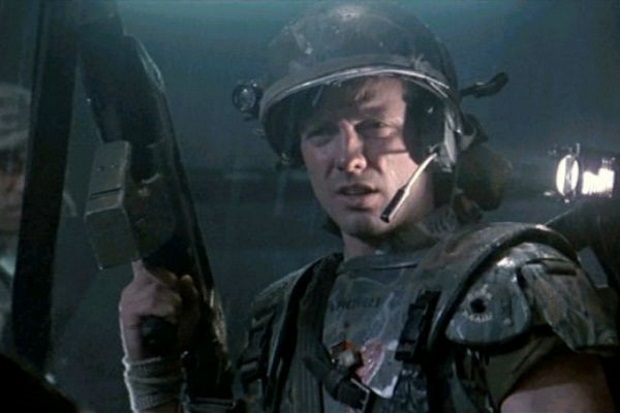
Gibson then began working from a 15-page treatment by Hill and Giler, which combined Cold War paranoia with some 1980’s body horror. The screenplay opens on the Sulaco travelling back home after the events of Aliens, with Ripley and friends in hypersleep. Unfortunately, the ship drifts into a corner of space claimed by the Union of Progressive Peoples, who are, in short, space communists. The U.P.P. board the ship to investigate the trespass, but one of the boarding party is attacked by a facehugger when he opens Bishop’s pod and finds an Alien egg has grown from the android’s torso. It appears the Alien Queen deposited a nasty xenovirus when she tore Bishop in half, leading to the growth of this egg.
The facehugged U.P.P soldier is soon ejected out an airlock by his teammates, who then take Bishop’s body for further study. The Sulaco is then left to drift to Anchorpoint, a partially completed station under Colonial Administration. Some marines board the ship, only to get attacked by two drones (sadly the script makes no attempt to explain where the hell they came from) and in the ensuring firefight Ripley’s pod is damaged, leaving her in a coma for the rest of the story.
Xeno evil, hear no evil
The first half of the screenplay concerns both U.P.P. and Anchorpoint scientists– the latter led by representatives from Weyland – Yutani, of course – separately experimenting on this xenovirus, which is highly adaptable. It can take over human or animal cells in a matter of seconds, leading to the creation of human/Alien hybrids. The story frames the virus as a HIV metaphor and one of the most memorable sequences involves the first appearance of a hybrid, where an infected character undergoes ‘The Change and gruesomely tears their skin off to reveal the beast beneath. It’s easy to imagine Rick Baker or Rob Bottin in their heyday having fun with such a transformation.
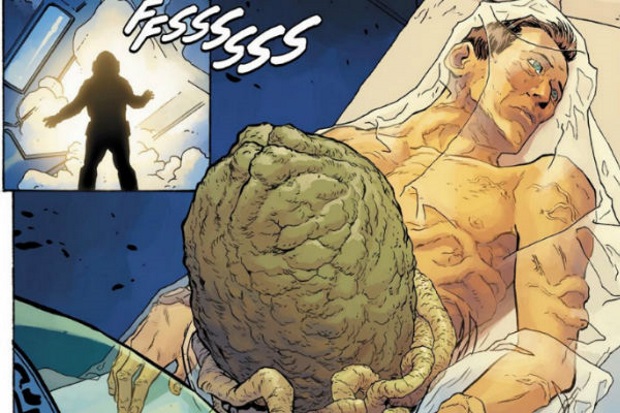
The script also posits the virus is some ancient biological weapon and was designed by another race. This notion goes back to Ridley Scott’s theories on the origin of the Alien and Space Jockey – long before he tackled the answer in Prometheus – and it’s an angle Gibson agreed with. In theory, the xenovirus should add some Thing-like paranoia since the infected can undergo the change without warning, but since the rules are so ill-defined it can feel random.
While the virus experimentation is happening, Hicks is on the sidelines exploring Anchorpoint – which has a small civilian population and a futuristic mall– and meeting the new cast of characters. Hicks is portrayed as more cynical than in Aliens, which is understandable really. He’s no less heroic though, and when the alien spores hit the fan – literally in this case, with most of the station becoming infected via airborne virus spread through the vents – he leads the survivors through the crumbling station to safety.
Reading the script it’s obvious Gibson is a fan of the series, and he drops numerous easter eggs and nods throughout, including a gratuitous Power Loader cameo. Given his cyberpunk leanings Gibson admitted Bishop was his favourite character, so the kindly android is given more to do. After the U.P.P. access his memories and take what they need, they repair him and send him back to Anchorpoint as a diplomatic gesture. The script toys with the notion they may have implanted him with nefarious goals, but thankfully he doesn’t turn traitor and even gets to blast some xenos with a pulse rifle in the finale.
Newt doesn’t get much to do, but she has a much happier ending than in Fincher’s movie; around the midway point she’s sent back to Earth to live with her grandparents, whilst leaving Ripley a hand drawn map to come find her when she wakes up.
Gibson’s first Alien III draft is tonally in line with Cameron’s Aliens, so once the virus infects Anchorpoint the story rarely pauses, layering setpiece upon setpiece. Standouts sequences include an attack on a mutant Alien Queen and a finale where the survivors don spacesuits for a walk outside Anchorpoint. While the relentless pacing is fun it does come at the expense of characterization. A lot of the supporting players are meat to the slaughter, and while it’s nice to see Hicks promoted to lead, he doesn’t have much going on underneath the hood either.
Given that this was Gibson’s first script and was written in a hurry, it can feel a tad unfocused and rushed, with underdeveloped characters and interesting concepts – like the hybrid creature itself – breezed past quickly. It also would have been prohibitively expensive with Gibson stating he was told the script would cost about $170 million to make, but all that said it’s also a tense, rollicking adventure that’s loaded with imagination.
Three Aliens
Gibson also penned a second draft of Alien III that scaled things down considerably. In this version, Anchorpoint is nearly abandoned aside from a skeleton crew, there are no marines or weapons on the station and – in what feels like a pun on the screenwriter’s part – only three Aliens appear: two hybrids and a full-blown Starbeast. After the kitchen sink approach of the first script, the second draft tightens things considerably. Events and characters are condensed and the focus is on suspense and atmosphere. The script also makes the hybrid Alien the star of the show.
Gibson fleshes out the characters much better the second time too, so when someone bites the dust it stings a little more. Sadly, a lot of the standout setpieces didn’t make the transition; the cinematic spacewalk is gone, as is a sequence where Bishop is chased by an Alien Queen. The script withholds the appearance of a Giger Alien until the very end where it fights – and easily beats – a hybrid, but this reveal feels much too late and the creature is soon dispatched. This script also reveals what a bug hunt actually is; this is when marines are sent to a planet to wipe out the indigenous species, so the incoming human colonists have no natural competition.
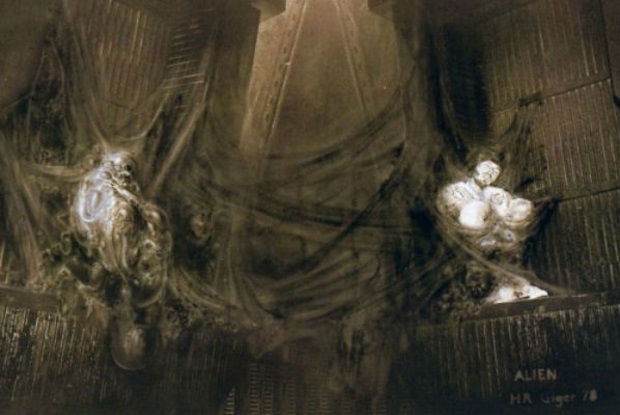
In another nod to Alien, Gibson also brought back the Eggmorph concept, when one nasty Weyland–Yutani executive meets a bad end via this method. It’s a question of taste over which script works best; for example, the nearly abandoned Anchorpoint in the second draft is a real creepy setting, yet without a population that gets destroyed by the virus like in the first script there’s little sense of the apocalyptic havoc it can reap. Maybe a third draft combining the strengths of both scripts would have seen the author truly nail it.
Alien Legacy
Little of Gibson’s work made it into Alien 3. There’s a U.P.P soldier with a barcode tattoo like the prisoners in the movie and the second draft features a line where Hicks is told there’s no armoury on the station. Gibson was also the first writer to bring in the notion of an Alien being born from animals, with a xenomorph lemur making a quick appearance; later screenplays and the final product would run with this. The idea of spores and germ warfare was later picked up in Prometheus and Covenant, and 2014 video game Alien: Isolation finds Ripley’s daughter Amanda alone on a space station that also features an eerily abandoned mall area.
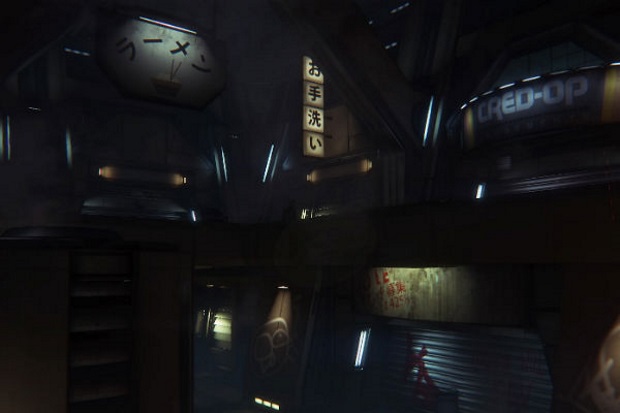
When Gibson was brought on the producers had the loose idea that Ridley Scott would direct Alien III and Cameron would take part four. Scott was approached, but while he was interested, he was busy with a number of other projects. Renny Harlin – fresh off A Nightmare On Elm Street 4 – was eventually hired, but while he and Gibson met to discuss further rewrites, the author elected to depart the project. Soon thereafter, his screenplay was thrown out and Harlin would begin his own tortured path trying to find a good story, before eventually bowing out a year later.
As for a potential Alien 4, Gibson’s scripts lay some seeds for what could have happened. Ripley is placed on an evacuation pod by Hicks as Anchorpoint starts to go to hell, setting up her return for the next adventure. Both drafts end with Bishop giving a philosophical speech about how humanity must unite against the Aliens, and trace them back to their home planet to wipe them out. It appears the homeworld would have been the setting for the movie, though it’s mentioned the Sulaco is also carrying some xenovirus samples back to Gateway Station, so maybe the concept of an outbreak on Earth was also being toyed with.
Gibson’s script receives a lot of fan love for being a fascinating, what-if scenario for the series and it’s easy to see why. While both drafts have issues and Ripley is certainly missed, Gibson’s respect for the material and efforts to inject new ideas in the franchise make his Alien III a quality piece of work. Hopefully the forthcoming comic will finally do his concept justice after 30 years of waiting.
Read the latest Den of Geek Special Edition Magazine Here!